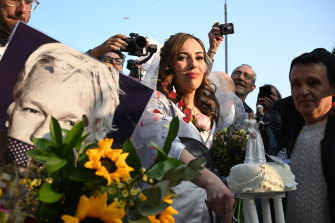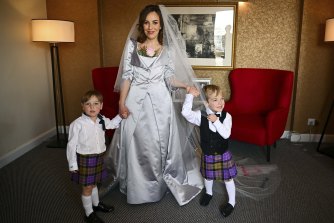Bugged embassy bathrooms and a wedding in prison: life married to Julian Assange
Three weeks ago, on the day that British Home Secretary Priti Patel approved the extradition of the WikiLeaks co-founder Julian Assange to America – for trial under the US Espionage Act – guards entered Assange’s cell in Belmarsh prison. He was strip-searched, then locked in a bare cell and put on enhanced suicide watch.
“This is the kind of thing Julian has no control over,” his wife, Stella Assange, tells me. Assange, she says, is usually locked in his cell for more than 20 hours a day. “So he was even more isolated than usual [while] processing that news. And then he was eventually moved back after two or three days and his cell had been searched.”
Stella Assange speaks to supporters outside Belmarsh prison after marrying Julian Assange.Credit:Getty
Assange has been held in Belmarsh since April 2019, when he was dragged out of the Ecuadorian embassy in London. He had spent seven increasingly surreal years there, after skipping bail to avoid extradition to Sweden to face allegations of rape and sexual assault. The charges were later dropped.
For Stella, too, Patel’s decision was the latest blow in her relationship with Assange that, by any standards, has been extraordinary. For much of the 11 years she has been involved with Assange he has been in a condition of captivity – self-imposed as it was at the Ecuadorian embassy, where their two children, aged three and five, were conceived; and in Belmarsh, where the couple married in March. Unsurprisingly, she believes his detention is a “travesty of justice” and today sees the latest attempt by his supporters to put his side of the story, with the release of a documentary. Ithaka: A Father, a Family, a Fight for Justice chronicles Assange’s battle against extradition through the eyes of his wife and his 75-year-old father, John Shipton.
But, for many, Assange is a hard person to feel sympathy for. Initially lionised for WikiLeaks’ role in exposing corruption in governments around the world and the hidden side of American action in Iraq and Afghanistan, he is a man who somehow managed to antagonise and alienate former colleagues and friends, lawyers, publishers and newspaper editors who worked with him, and even his closest supporters.
Writing in the London Review of Books in 2014, the novelist Andrew O’Hagan, who spent months with Assange in 2011 attempting to ghost his autobiography, painted a portrait of a narcissist, who “hates all systems” and “[treats] his supporters as subjects”. The film producer Jemima Khan, one of those who stood bail for Assange, later reflected that his “rock-star status” had made him think he was “above the law and exempt from criticism”.
He has been described as “a useful idiot” for the Russians, referring to the leaking of Hillary Clinton’s private emails in 2016, which arguably aided Donald Trump’s run for the presidency. (“I love WikiLeaks!” Trump said at the time.)
But all of this is by the by.
In the US, Assange is facing a total of 18 charges related to his alleged role in conspiring with Chelsea Manning, then a US intelligence analyst, to release classified military documents – charges that could see Assange sentenced to 175 years in prison.
It is a case, say his supporters, that not only sets a dangerous precedent for press freedom and the right of journalists to hold the powerful to account, but has also turned the British court system into a proxy for a US government that wants to punish Assange for exposing some of its military’s most appalling activities.
Stella Assange with her sons Max and Gabriel before driving to Belmarsh prison to marry Assange.Credit:AP
Stella Assange is 39, dark-haired with wide, luminous eyes. Talking on Zoom from the house in west London where she lives with her and Assange’s two children, Max and Gabriel, she looks strained and talks hesitantly, pausing before answering questions, then pausing again to start afresh, as if careful that anything she says might somehow weigh against Assange’s predicament.
Born in South Africa to parents who were anti-apartheid activists, she first met Assange in 2011 at London’s Frontline Club, after joining his legal team. She remembers her first impressions of him as being “very unusual. Like a rare creature.”
“He didn’t give much away,” she adds. “But I admired what he’d done with WikiLeaks; I thought it was extraordinary and transformative and it was very clear to me that, despite all the public exposure he’d had, he was, in fact, in a vulnerable situation.”
And she felt protective of him? “I think so, yeah. And I also thought, ‘This guy needs all the help he can get’.”
It was not until 2015, she says, that they became a couple. “I got to know Julian as a person, as someone who was funny, who tells stories. And also I got to know him under a lot of pressure; it really felt – and feels – that we were up against something very sinister and powerful and you learn about yourself, and you learn a lot about other people in that situation. And I got to know a side of him that was very soft and caring. A side to him that people don’t generally see.”
“They’re afraid of him being seen as a human being.”
She says the atmosphere inside the Ecuadorian embassy, although benign at first, turned hostile after a change of government in Ecuador, and a change of embassy staff.
Assange, who previously was free to move about the building, was confined to two rooms. They would do pat-down searches “out of nowhere” and visits were restricted to office hours.
“From Friday at 5pm to 9am on Monday he wouldn’t see another soul,” she says. “When he went down the corridor to the toilet or the kitchen, a security guard would follow. There were CCTV cameras everywhere.” She and Assange would conduct legal conversations in the women’s bathroom. “There were things we didn’t want overheard.” It was only after Assange had been expelled from the embassy that she discovered that the bathroom had also been bugged. “There’s nowhere they wouldn’t go.”
At one point they even erected a small tent in his room to ensure privacy. Their first child, Gabriel, was born in 2016. “I was very afraid when I was there that something would happen to Julian. I was afraid for myself. I thought they could hurt me as a way to get at him, especially knowing I was in such a vulnerable position.”
Her fears for Assange’s safety were, it seems, justified – it was reported last November that senior CIA and Trump administration officials discussed the possibility of kidnapping or killing him after being angered by WikiLeaks’ 2017 publication of CIA hacking secrets.
Today, Stella visits Assange in Belmarsh twice a week, and speaks to him every day on the phone. Their wedding in the prison was attended by members of their family. Fashion designer Vivienne Westwood, a long-time supporter, gave Stella a wedding dress and a kilt for Assange to wear as presents. A request to take photographs was denied; instead, Belmarsh provided its own photographer. When Stella received the pictures, they were printed on ordinary paper and slightly out of focus, with an order that they should not be published.
“They’re afraid of him being seen as a human being or people being reminded or aware that he’s been in prison for over three years, and start to think differently about him and what’s been done to him,” she says.
Assange is appealing against Patel’s decision to extradite, a process likely to take months. “It’s so incredibly unjust, every little piece of it. And that can be overwhelming, but what can you do? You just have to continue fighting.”
When she first became involved in Assange’s case, she says, “it was clear that it wasn’t going to be easy”. But surely she could never have anticipated her life would take quite the turn it has. She shrugs.
“Well, I guess you choose your life and then life chooses you. This is the path that it’s taken. The main thing is: Julian is my husband, he’s my other half. Whatever journey that involves, it’s no longer a choice.”
Telegraph, London
Get a note directly from our foreign correspondents on what’s making headlines around the world. Sign up for the weekly What in the World newsletter here.
Most Viewed in World
From our partners
Source: Read Full Article

